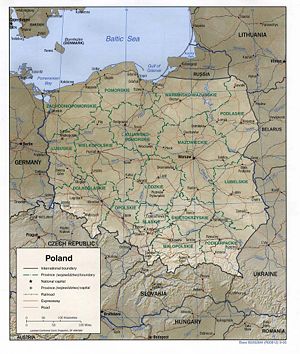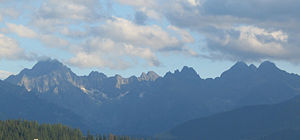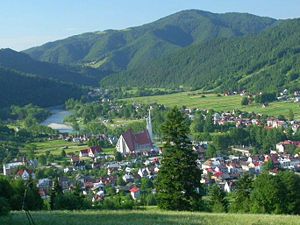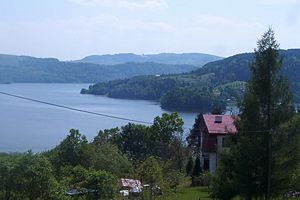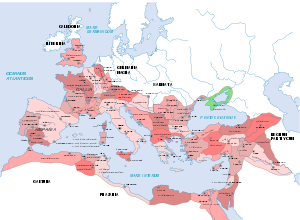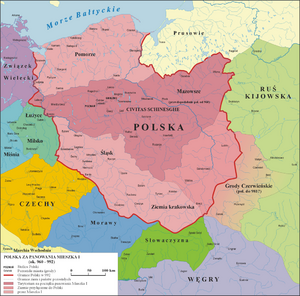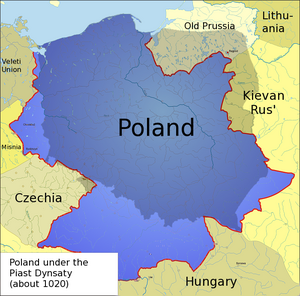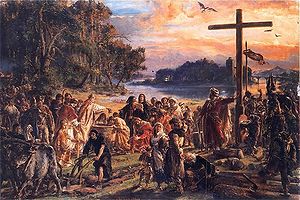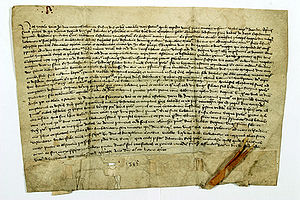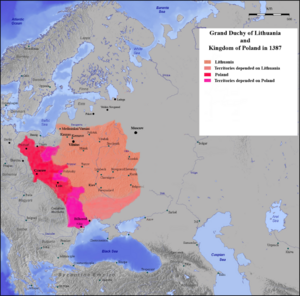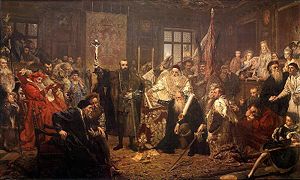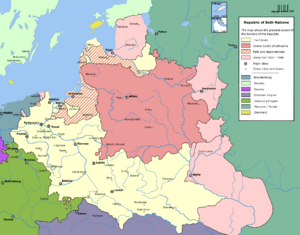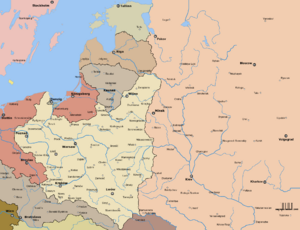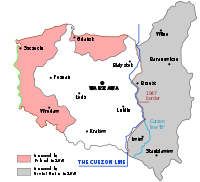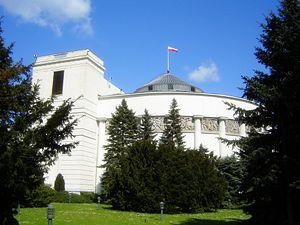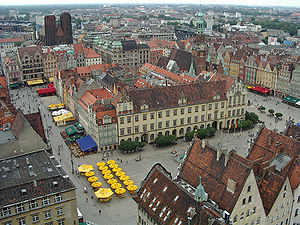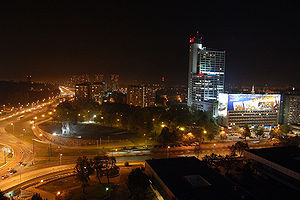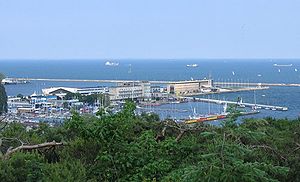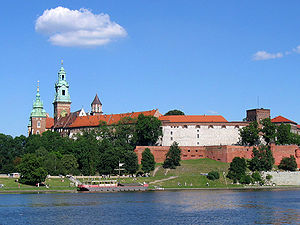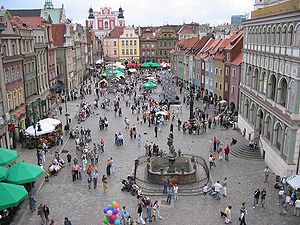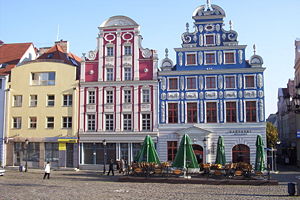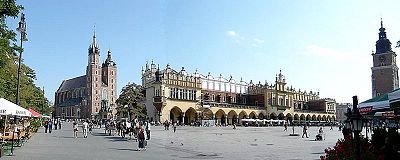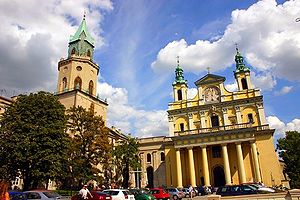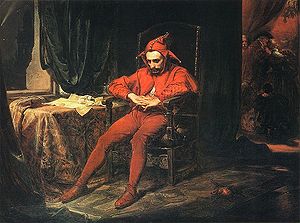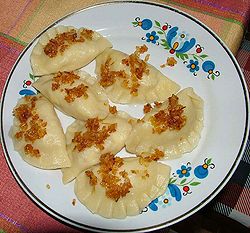Difference between revisions of "Poland" - New World Encyclopedia
Mike Butler (talk | contribs) |
Mike Butler (talk | contribs) |
||
| Line 130: | Line 130: | ||
[[Image:Zaprowadzenie chrzescijanstwa 965 Matejko.JPG|thumb|left|300px|“Christianization of Poland“ by [[Jan Matejko]] ]] | [[Image:Zaprowadzenie chrzescijanstwa 965 Matejko.JPG|thumb|left|300px|“Christianization of Poland“ by [[Jan Matejko]] ]] | ||
[[Image:Union of Krewo.jpg|thumb|300px|left|The document signed in [[Kreva]] on August 14, 1385.]] | [[Image:Union of Krewo.jpg|thumb|300px|left|The document signed in [[Kreva]] on August 14, 1385.]] | ||
| − | |||
| − | |||
===Prehistory=== | ===Prehistory=== | ||
The Stone Age era in Poland lasted 500,000 years and involved three different [[Human|human species]]. The [[Stone Age]] cultures ranged from early human groups with primitive tools to advanced [[Agriculture|agricultural]] societies using sophisticated [[stone tool]]s, building fortified settlements and developing [[copper]] [[metallurgy]]. | The Stone Age era in Poland lasted 500,000 years and involved three different [[Human|human species]]. The [[Stone Age]] cultures ranged from early human groups with primitive tools to advanced [[Agriculture|agricultural]] societies using sophisticated [[stone tool]]s, building fortified settlements and developing [[copper]] [[metallurgy]]. | ||
| Line 183: | Line 181: | ||
===Jewish settlement=== | ===Jewish settlement=== | ||
The [[Jew]]s, persecuted all over Europe during the [[Crusades]], fled to Poland where they were welcomed, settled in the towns, and began to carry on commerce and banking. An illustration of Poles' friendliness towards these newcomers is the statute of [[Kalisz]], promulgated by Prince Boleslav in the year 1246 by which the Jews received every protection, of the law and which imposed heavy penalties for any insults to their cemeteries, synagogues and, other sanctuaries. About the same time Prince Henry IV of [[Wrocław]] (Breslau) imposed heavy penalties upon those who accused Jews of ritual murder - this was a common anti-Semitic slander across Europe at the time. Anyone who made such an accusation had to prove it by six witnesses, three Gentiles and three Jews, and in case of his inability to prove the charge in a satisfactory manner he was himself found guilty and subject to severe punishment. | The [[Jew]]s, persecuted all over Europe during the [[Crusades]], fled to Poland where they were welcomed, settled in the towns, and began to carry on commerce and banking. An illustration of Poles' friendliness towards these newcomers is the statute of [[Kalisz]], promulgated by Prince Boleslav in the year 1246 by which the Jews received every protection, of the law and which imposed heavy penalties for any insults to their cemeteries, synagogues and, other sanctuaries. About the same time Prince Henry IV of [[Wrocław]] (Breslau) imposed heavy penalties upon those who accused Jews of ritual murder - this was a common anti-Semitic slander across Europe at the time. Anyone who made such an accusation had to prove it by six witnesses, three Gentiles and three Jews, and in case of his inability to prove the charge in a satisfactory manner he was himself found guilty and subject to severe punishment. | ||
| + | |||
| + | The [[Black Death]] which affected most parts of Europe from 1347 to 1351 did not reach Poland. | ||
===Polish-Lithuanian Union=== | ===Polish-Lithuanian Union=== | ||
| + | [[image:Lietuva ir Lenkija.Lithuania and Poland 1387.png|thumb|300px|left|Poland and Lithuania in 1387]] | ||
| + | [[Image:Unia Lubelska.JPG|300px|left|thumb|The Union of Lublin. Painting by [[Jan Matejko]].]] | ||
| + | [[Image:Rzeczpospolita.png|thumb|left|300px|The Polish-Lithuanian Commonwealth at its greatest extent.]] | ||
The regional division ended when [[Władysław I the Elbow-high]] (1261-1333) united the various principalities of [[Poland]]. His son [[Casimir III of Poland|Kazimierz the Great]] (1310-1370), the last of the [[Piast]] dynasty, considerably strengthened the country's position in both foreign and domestic affairs. Before his death in 1370, the heirless king arranged for his nephew, the [[Andegawen]] [[Louis I of Hungary|Louis of Hungary]], to inherit the throne. In 1385, the [[Union of Krewo]] was signed between Louis' daughter [[Jadwiga of Poland|Jadwiga]] and [[Jogaila]], Grand Duke of Lithuania (later known as Władysław II Jagiełło), beginning the [[Polish-Lithuanian Union]] and strengthening both nations in their shared opposition to the Teutonic Knights and the growing threat of [[Grand Duchy of Moscow]]. Władysław, who was converted on his accession, introduced Christianity into [[Lithuania]], a pagan country. | The regional division ended when [[Władysław I the Elbow-high]] (1261-1333) united the various principalities of [[Poland]]. His son [[Casimir III of Poland|Kazimierz the Great]] (1310-1370), the last of the [[Piast]] dynasty, considerably strengthened the country's position in both foreign and domestic affairs. Before his death in 1370, the heirless king arranged for his nephew, the [[Andegawen]] [[Louis I of Hungary|Louis of Hungary]], to inherit the throne. In 1385, the [[Union of Krewo]] was signed between Louis' daughter [[Jadwiga of Poland|Jadwiga]] and [[Jogaila]], Grand Duke of Lithuania (later known as Władysław II Jagiełło), beginning the [[Polish-Lithuanian Union]] and strengthening both nations in their shared opposition to the Teutonic Knights and the growing threat of [[Grand Duchy of Moscow]]. Władysław, who was converted on his accession, introduced Christianity into [[Lithuania]], a pagan country. | ||
| − | + | In 1410 a polish-Lithuanian army inflicted decisive defeat to the armies of [[Teutonic Knights]], both countries' main adversary, in the [[battle of Grunwald]]. After [[Thirteen Years War]] the Knights state has been reduced to polish vassal. Thereafter, until 1569, a single sovereign usually ruled both states. Polish culture and economy flourished under Jagiellons, and the country produced such figures as astronomer Nicolaus Copernicus and poet Jan Kochanowski. Compared to other European nations, Poland was exceptional in its tolerance for religious dissent, allowing the country to avoid religious turmoil that spread over Western Europe in that time. | |
| − | |||
| − | |||
| − | |||
| − | |||
| − | |||
| − | |||
| − | In 1410 a polish-Lithuanian army inflicted decisive defeat to the armies of [[Teutonic Knights]], both countries' main adversary, in the [[battle of Grunwald]]. After [[Thirteen Years War]] the Knights state has been reduced to polish vassal. Polish culture and economy flourished under Jagiellons, and the country produced such figures as astronomer Nicolaus Copernicus and poet Jan Kochanowski. Compared to other European nations, Poland was exceptional in its tolerance for religious dissent, allowing the country to avoid religious turmoil that spread over Western Europe in that time. | ||
===Polish-Lithuanian Commonwealth=== | ===Polish-Lithuanian Commonwealth=== | ||
| − | + | The [[Union of Lublin]] was a political act, signed July 1, 1569, in [[Lublin]], [[Poland]], which united the Kingdom of Poland and the [[Grand Duchy of Lithuania]] into a single state, the [[Polish-Lithuanian Commonwealth]]. The [[Commonwealth]] was ruled by a single [[elective monarchy|elected monarch]] who carried on the duties of [[Polish king|Polish King]] and [[Lithuanian grand duke|Grand Duke of Lithuania]], and governed with a common [[Senate]] and [[diet (assembly)|parliament]] (the ''[[Sejm]]''). The union was an evolutionary stage in the [[Polish-Lithuanian Union|Polish-Lithuanian alliance and personal union]], necessitated by Lithuania's dangerous position in wars with [[Russia]]. By creating the largest state in Europe, Lithuania could hope to defend itself against its much more powerful neighbor. | |
| − | [[ | ||
| − | |||
| − | |||
| − | |||
| − | |||
| − | |||
| − | |||
| − | |||
| − | |||
| − | |||
| − | + | [[Sigismund II Augustus]], the last of the Jagiełłonians, died in 1572. The Polish nobility instituted a regime whereby kings were elected by the Sejm, then a bicameral body consisting of the lesser and greater nobility. Any member of the Sejm could prevent the passage of legislation with the ''liberum veto''. The constitution enabled nobles to form military confederations. | |
| + | A [[Polish Golden Age|golden age]] ensued during the sixteenth century. The ''[[szlachta]]'' (nobility) of Poland, far more numerous than in [[Western Europe]]an countries, took pride in [[Golden Liberty|their freedoms]] and [[Sejm|parliamentary system]]. During the Golden Age period, Poland expanded its borders to become the largest country in Europe. | ||
| + | Protestantism, which made many converts among the nobility in the middle years of the sixteenth century, ceased to be significant after 1600. | ||
| − | + | ===Golden age ends=== | |
| + | In the mid-seventeenth century, a [[Cossack]]'s [[Chmielnicki Uprising]] (1648-1654) which ravaged the country, and a [[Sweden|Swedish]] invasion ([[The Deluge (Polish history)|"The Deluge"]]) (1655-1660) marked the end of the golden age. [[Polish-Russian War|Numerous wars against Russia]] coupled with government inefficiency caused by the ''[[Liberum Veto]]'', marked the steady deterioration of the Commonwealth from a European power into a near-[[anarchy]] controlled by its neighbours. The reforms, particularly those of the [[Great Sejm]], which passing of the [[Constitution of May 3, 1791]], second modern constitution of the world, were thwarted with the three [[partitions of Poland]] (1772, 1793, and 1795) which ended with Poland's being erased from the map and its territories being divided between [[Russia]], [[Prussia]], and [[Austria]]. | ||
===Partitions of Poland=== | ===Partitions of Poland=== | ||
Revision as of 04:26, 1 December 2007
| Rzeczpospolita Polska Republic of Poland |
||||||
|---|---|---|---|---|---|---|
|
||||||
| Motto: See: unofficial mottos of Poland | ||||||
| Anthem: Mazurek Dąbrowskiego (Polish) Dąbrowski's Mazurek |
||||||
| Location of Poland (orange) – on the European continent (camel white) – in the European Union (camel) [Legend] |
||||||
| Capital (and largest city) | Warsaw 52°13′N 21°02′E | |||||
| Official languages | Polish² | |||||
| Demonym | Pole | |||||
| Government | Parliamentary republic | |||||
| - | President | Lech Kaczyński | ||||
| - | Prime Minister | Donald Tusk | ||||
| Formation | ||||||
| - | Christianisation4 | 14 April 966 | ||||
| - | Redeclared | 11 November 1918 | ||||
| EU accession | 01 May 2004 | |||||
| Area | ||||||
| - | Total | 312,679 km² (6Template:9th³) 120,728 sq mi |
||||
| - | Water (%) | 3.07 | ||||
| Population | ||||||
| - | 2007 estimate | 38,518,241 (33rd) | ||||
| - | 2002 census | 38,530,080 | ||||
| - | Density | 122/km² (83rd) 319.9/sq mi |
||||
| GDP (PPP) | 2007 estimate | |||||
| - | Total | $631.8 billion (IMF) (24) | ||||
| - | Per capita | $16,599 (IMF) (52) | ||||
| GDP (nominal) | 2007 estimate | |||||
| - | Total | $413.3 billion (IMF) | ||||
| - | Per capita | $10,858 (IMF) | ||||
| Currency | Złoty (PLN) |
|||||
| Time zone | CET (UTC+1) | |||||
| - | Summer (DST) | CEST (UTC+2) | ||||
| Internet TLD | .pl5 | |||||
| Calling code | +48 | |||||
| 1 See, however, Unofficial mottos of Poland. ² Although not official languages, Kashubian, Lithuanian and German are used in 19 communal offices. ³ The area of Poland according to the administrative division, as given by the Central Statistical Office,[1] amounts to 312,679 km²: land area (311 888 km²) and part of internal waters (791 km²) cut by the coast line. The area of Poland's territory, including all internal waters and the territorial sea, is 322 575 km². 4 The adoption of Christianity in Poland is seen by many Poles, regardless of their religious affiliation, as one of the most significant national historical events; the new religion was used to unify the tribes in the region. 5 Also .eu, as Poland is a member of the European Union. |
||||||
Poland (Polish: Polska), officially the Republic of Poland (Polish: Rzeczpospolita Polska), is a country in Central Europe on the boundary between Eastern and Western European continental masses, and is considered at times a part of Eastern Europe.
The first Polish state was baptized in 966, within territory similar to the present boundaries of Poland. Poland became a kingdom in 1025, and in 1569 it cemented a long association with the Grand Duchy of Lithuania by uniting to form the Polish-Lithuanian Commonwealth. The Commonwealth collapsed in 1795. Poland regained its independence in 1918 after World War I but lost it again in World War II, occupied by Nazi Germany and the Soviet Union, emerging several years later as a communist country within the Eastern Bloc under the control of the Soviet Union.
In 1989, communist rule was overthrown and Poland became what is informally known as the "Third Polish Republic".
Poland is the 33rd most populous country in the world. Poland is a unitary state made up of sixteen voivodeships (Polish: województwo). Poland is also a member of the European Union, NATO and OECD.
Geography
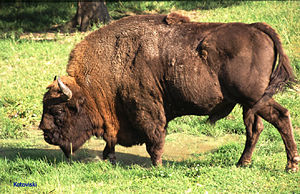
Poland is bordered by Germany to the west; the Czech Republic and Slovakia to the south; Ukraine and Belarus to the east; and the Baltic Sea, Lithuania and Kaliningrad Oblast, a Russian exclave, to the north. The total area of Poland is 120,728 square miles (312,679 square kilometers) making it the 69th largest country in the world and seventh in Europe — or slightly smaller than New Mexico in the United States.
The geological structure of Poland has been shaped by the continental collision of Europe and Africa over the past 60 million years, on the one hand, and the Quaternary glaciations of northern Europe, on the other. Both processes shaped the Sudetes and the Carpathians. The moraine landscape of northern Poland contains soils made up mostly of sand or loam, while the ice-age river valleys of the south often contain loess. The Cracow-Częstochowa Upland, the Pieniny, and the Western Tatras consist of limestone, while the High Tatras, the Beskids, and the Karkonosze are made up mainly of granite and basalts. The Kraków-Częstochowa Upland is one of the oldest mountain ranges on earth.
Poland’s territory extends across five geographical regions. In the northwest is the Baltic seacoast, marked by several spits, coastal lakes (former bays that have been cut off from the sea), and dunes. The centre and parts of the north lie within the Northern European Lowlands. Rising gently above these lowlands is a geographical region comprising the four hilly districts of moraines and moraine-dammed lakes formed during and after the Pleistocene ice age.
The Masurian Lake District is the largest of the four and covers much of northeastern Poland. The lake districts form part of the Baltic Ridge, a series of moraine belts along the southern shore of the Baltic Sea. South of the Northern European Lowlands lie the regions of Silesia and Masovia, which are marked by broad ice-age river valleys. Farther south lies the Polish mountain region, including the Sudetes, the Cracow-Częstochowa Upland, the Świętokrzyskie Mountains, and the Carpathian Mountains, including the Beskids. The highest part of the Carpathians is the Tatra Mountains, along Poland’s southern border.
Poland has 21 mountains over 6561 feet (2000 meters) in elevation, all in the High Tatras. In the High Tatras lies Poland’s highest point, the northwestern peak of Rysy, at 8198 feet(2499 meters) in elevation. At its foot lies the mountain lake, the Morskie Oko. Among the most beautiful mountains of Poland are the Bieszczady Mountains in the far southeast of Poland, whose highest point in Poland is Tarnica, with an elevation of 4416 feet (1346 meters). Tourists also frequent the Gorce Mountains in Gorce National Park. The lowest point in Poland -— at (7 feet (two meters) below sea level -— is at Raczki Elbląskie, near Elbląg in the Vistula Delta.
The climate is oceanic in the north and west and becomes gradually warmer and continental as one moves south and east. Summers are generally warm, with average temperatures between 68°F (20°C) and 80.6°F (27°C. Winters are cold, with average temperatures around 37.4°F (3°C) in the northwest and 17.6°F (–8°C) in the northeast. Precipitation falls throughout the year, although, especially in the east; winter is drier than summer. The warmest region in Poland is Lesser Poland located in Southern Poland where temperatures in the summer average between 73.4°F (23°C) and (86°F (30°C). The coldest region is in the northeast in the Podlachian Voivodeship near the border of Belarus. Cold fronts which come from Scandinavia and Siberia bring temperatures in the winter in Podlachian ranging from 5°F (-15°C) to 24.8°F (-4°C).
The longest rivers are the Vistula, 678 miles (1047km) long; the Oder—which forms part of Poland’s western border— 531 miles (854km) long; its tributary, the Warta, 502 miles (808km) long; and the Bug —a tributary of the Vistula—480 miles (772km) long. The Vistula and the Oder flow into the Baltic Sea, as do numerous smaller rivers in Pomerania. The Łyna and the Angrapa flow by way of the Pregolya to the Baltic, and the Czarna Hańcza flows into the Baltic through the Neman.
Poland’s rivers have been used since early times for navigation. The Vikings, for example, traveled up the Vistula and the Oder in their longships. In the Middle Ages and in early modern times, when Poland-Lithuania was the breadbasket of Europe, the shipment of grain and other agricultural products down the Vistula toward Gdańsk and onward to western Europe took on great importance. For an overview of the most important rivers in Poland, see Category:Rivers of Poland.
With almost ten thousand closed bodies of water covering more than one hectare (2.47 acres) each, Poland has one of the highest numbers of lakes in the world. The largest lakes, covering more than 38.6 square miles (100 square kilometers) are Lake Śniardwy and Lake Mamry in Masuria, as well as Lake Łebsko and Lake Drawsko in Pomerania.
Among the first lakes whose shores were settled are those in the Greater Polish Lake District. The stilt house settlement of Biskupin, occupied by more than one thousand residents, was founded before the seventh century B.C.E. by people of the Lusatian culture. The ancestors of today’s Poles, the Polanie, built their first fortresses on islands in these lakes. The legendary Prince Popiel is supposed to have ruled from Kruszwica on Lake Gopło. The first historically documented ruler of Poland, Duke Mieszko I, had his palace on an island in the Warta River in Poznań.
Błędów Desert is a desert located in Southern Poland in the Lesser Poland region it also stretches over the Zagłębie Dąbrowskie region. It has a total area of 32km². It is the only desert located in Poland, and is one of five natural deserts in Europe. It was created thousands of years ago by a melting glacier. The specific geological structure has been of big importance - the average thickness of the sand layer is about 40 meters (maximum 70 meters), which made the fast and deep drainage very easy. In recent years the desert has started to shrink. The phenomenon of mirages has been known to exist there.
More than one percent of Poland’s area -— 1214 square miles (3145 square kilometers) —is protected within 23 national parks. In this respect, Poland ranks first in Europe. Forests cover 28 of Poland’s land area. More than half of the land is devoted to agriculture. While the total area under cultivation is declining, the remaining farmland is more intensively cultivated.
Many animals that have since died out in other parts of Europe survive in Poland, such as the wisent in the ancient woodland of the Białowieża Forest and in Podlachia. Other such species include the brown bear in Białowieża, in the Tatras, and in the Beskids, the gray wolf and the Eurasian lynx in various forests, the moose in northern Poland, and the beaver in Masuria, Pomerania, and Podlachia. In the forests, one also encounters game animals, such as red deer, roe deer, and boars. In eastern Poland there are a number of ancient woodlands, like Białowieża, that have never been cleared by people. There are also large forested areas in the mountains, Masuria, Pomerania, and Lower Silesia.
Poland is the most important breeding ground for European migratory birds. Out of all of the migratory birds who come to Europe for the summer, one quarter breed in Poland, particularly in the lake districts and the wetlands along the Biebrza, the Narew, and the Warta, which are part of nature reserves or national parks. In Masuria, there are villages in which storks outnumber people.
Flooding is a natural hazard. Environmental issues relate to air pollution, which remained serious in 2007 because of sulfur dioxide emissions from coal-fired power plants, and the resulting acid rain which damages forest. Water pollution from industrial and municipal sources is also a problem, as is disposal of hazardous wastes. Pollution levels were expected to decrease as industrial establishments bring their facilities up to the European Union code, but at substantial cost to business and the government.
Warsaw is the capital of Poland and is its largest city. Located on the Vistula River between the Baltic Sea coast and the Carpathian Mountains, its population in 2006 was estimated at 1,700,536, with a metropolitan area of approximately 2,600,000. The largest metropolitan areas in Poland are the Upper Silesian Coal Basin centred on Katowice (3.5 million inhabitants); Łódź (1.3 million); Kraków (1.3 million); the “Tricity” of Gdańsk-Sopot-Gdynia in the Vistula delta (1.1 million); Poznań (0.9 million); Wrocław (0.9 million); and Szczecin (0.9 million). For an overview of Polish cities, see List of cities in Poland.
History
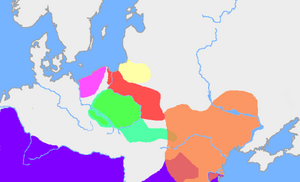
Prehistory
The Stone Age era in Poland lasted 500,000 years and involved three different human species. The Stone Age cultures ranged from early human groups with primitive tools to advanced agricultural societies using sophisticated stone tools, building fortified settlements and developing copper metallurgy.
Early Bronze Age cultures in Poland begin around 2400/2300 B.C.E. The Iron Age commences ca. 750/700 B.C.E. The most famous archeological finding is the Biskupin fortified settlement on the lake, of the Lusatian culture of the early Iron Age, by some past researchers considered to be a Proto-Slavic development. Biskupin is an archaeological site and a life-size model of an Iron Age fortified settlement (gród) in Poland, Kuyavian-Pomeranian Voivodship.
Celtic, Germanic and Baltic tribes
Peoples belonging to numerous archeological cultures identified with Celtic, Germanic and Baltic tribes lived in various parts of Poland from about 400 B.C.E. Other groups were no doubt also present. Short of using written language, many of them developed advanced material culture and social organization. Characteristic of the period was relatively high geographical mobility of large groups of people, even equivalents of today's nations. The Germanic people lived in today's Poland for several centuries, while many of their tribes also migrated out in the southern and eastern directions.
Roman Empire
With the expansion of the Roman Empire came also the first written remarks by Roman authors that are relevant to the developments on Polish lands. They provide additional insight when compared with the archeological record. In the end, as the Roman Empire was nearing its collapse and the nomadic peoples invading from the east destroyed, damaged or destabilized the various Germanic cultures and societies, the Germanic people left eastern and central Europe for the safer and wealthier southern and western parts of the continent. The northeast corner of contemporary Poland's territory was and remained populated by Baltic tribes.
Slavic tribal society
Whether Slavic tribes were indigenous to the lands that were to become Poland or migrated there from elsewhere is in dispute. The Slavs were "known to other people" as those tribes located between the Vistula and Dnepr until the middle of the first century B.C.E. After that they expanded to the Elbe (Labe) River and Adriatic Sea and down the Danube.
Slavic people were markedly less developed than Germanic people of the time, which can be seen from the comparable quality of the pottery and other artifacts left by the two groups. They lived from cultivation of crops and were generally farmers, but also engaged in hunting and gathering. Their migration was probably caused by the pursuit of fertile soils and persistent attacks on eastern and central Europe by waves of people and armies from the east, such as the Huns, Avars and Magyars. A westward movement of Slavic people was facilitated in part by the previous withdrawal of Germanic people and their own migration toward the safer and more attractive areas of western and southern Europe.
A number of such Polish tribes formed small states beginning in eighth century, some of which coalesced later into larger ones. Among those were the Vistulans (Wiślanie) in southern Poland with Kraków and Wiślica as their main centers, and later the eastern and western Polans (Polanie, lit. "people of the fields).
The tribal states built many gords - fortified structures with primitive walls enclosing a group of wooden houses, built either in rows or in circles, from the seventh century on. Some of them were developed and inhabited, other had a very large empty area and may had served primarily as refuges in times of trouble. The Polans settled in the flatlands around Giecz, Poznań and Gniezno that eventually became the foundation and early center of Poland, lending their name to the country.
Probably around 874, the Vistulans were subjugated by the Great Moravian king Svatopluk I, who was a vassal of the emperor Arnulf, and the Vistulan duke was forced to accept baptism. After a later period of Czech domination, the Vistulan lands became controlled by the Polans in late tenth century and were incorporated into Poland.
The eastern Polans, between the sixth and the ninth centuries, inhabited both sides of the Dnieper river from Liubech to Rodnia and also down the lower streams of the rivers Ros', Sula, Stuhna, Teteriv, Irpin', Desna and Pripyat. The eastern Polans played a key role in formation of Ukrainian ethnicity.
The western Polans inhabited the Warta river basin in the eighth century]]. In the late ninth century]] they managed to subdue most of the Slavic tribes between the Odra and Western Bug rivers and between the Carpathians and the Baltic Sea. By the tenth century]] they managed to also integrate the lands of Masovia, Kujawy and Great Poland.
Christian kingdom
A number of tribes united, about 840 C.E., under a legendary king known as Piast. Poland's first historically documented ruler, Mieszko I (935-992), reputedly a descendant of Piast, was baptized in 966, adopting Catholic Christianity as the nation's new official religion, to which the bulk of the population converted in the course of the next centuries. Lands under Duke Mieszko's rule, including lands kept as vassal of the emperor and as margrave, encompassed Greater Poland, Lesser Poland, Masovia, Silesia and Pomerania. The lands totalled about 250,000 km² in area, with a population of about one million.
Mieszko's son and successor Boleslaw I (992-1025), known as the Brave, built on his father's achievements. He established the Christian Church and conducted successful wars against Holy Roman Emperor Henry II, expanding the Polish domain beyond the Carpathian Mountains and the Oder (Odra) and Dnestr rivers. The pope crowned him king by in 1025.
Poland then sustained years of internal disorder and invasions. Mieszko II, who was crowned in 1025, faced a rebellion by landlords, conflict with his brothers, and invasion by the troops of Holy Roman Emperor Conrad II. Casimir I of Poland (1037-1058) unified the country, Boleslav II of Poland made himself king in 1076, but had to abdicate in 1079. There was a conspiracy that involved Boleslav's brother Wladyslaw Herman (1040-1102) and the Bishop of Krakow. Boleslaw had Bishop of Krakow Stanislaw tortured and executed. However Boleslaw was forced to abdicate the Polish throne because of pressure from Catholic Church and nobility. Władysław I Herman took over the throne and also had to abdicate in 1102, giving the power to his sons Zbigniew of Poland and Bolesłav III Wrymouth who reigned simultaneously, until Boleslav had his half-brother banished from the country in 1107 and blinded in 1112, then executed.
Fragmentation
After Bolesłav III died in 1138, however, the kingdom was divided among four of his sons, ushering in a period of fragmentation. For two centuries, the Piasts sparred with each other, the clergy, and the nobility for control over the divided kingdom. Poland of the 13th century was no longer one solid political entity. By the "grace of God" the princes were absolute lords of their dominions. Church grew constantly stronger on account of its splendid organization, its accumulation of wealth and the moral control it exercised over the people. The sovereignty of the former state became diffused among a number of smaller independent principalities, with only the common bonds of language, race, religion and tradition.
German settlements
Civil strife and the Mongol invasions in 1241 and 1259, weakened and depopulated the small Polish principalities. As the territory became depopulated, the incomes of the princes began to decrease, prompting them to encourage immigration, causing a massive inflow of German settlers, bringing with them German laws and customs. German settlements sprang up along the wide belt which was laid waste by the Mongols in 1241, comprising present Galicia and Southern Silesia.
The entrepreneur who brought in a number of settlers, received, in addition to the compensation for his services, a piece of land for the colony of which he became came the chief (woyt), with hereditary right to certain taxes. These rights he could concede or sell. He was the judge of the colony, was free from all duties except those of a knight and a tax collector, and responsible to nobody except to the prince.
The settlers, after dividing among themselves the land granted to them by the Prince, proceeded to build a city with its town hall, market-place and church in the center. The streets radiated from the center, and the town was surrounded by a mound and ditch, beyond which lay the arable fields, pastures and woods. The settlers could build the towns in the way to which they were accustomed, and could govern themselves according to the practice of their native country.
The Teutonic Knights
In 1226, Konrad I of Masovia invited the Teutonic Knights to help him fight the pagan Prussian people on the border of his lands. In the following decades, the Teutonic Order conquered large areas long the Baltic Sea coast and established their monastic state. When virtually all of the former heathen Baltic people had become Christians, the Knights turned their attention to Poland and Lithuania, waging war with them for most of the fourteenth and fifteenth centuries until their remaining state was converted into the Protestant Duchy of Prussia under the King of Poland in 1525.
The Acts of Cienia
The twelfth and thirteenth centuries were marked by the economic and social evolution of Poland into a Western Christian state. In 1228, the Acts of Cienia were passed and signed into law by Duke Wladyslaw III (1165?-1231). He promised to provide a "just and noble law according to the council of bishops and barons." The Acts of Cienia were similar to the English Magna Carta of 1215. The Act of Cienia guaranteed Wladyslaw that he would become the next king of Poland.
Jewish settlement
The Jews, persecuted all over Europe during the Crusades, fled to Poland where they were welcomed, settled in the towns, and began to carry on commerce and banking. An illustration of Poles' friendliness towards these newcomers is the statute of Kalisz, promulgated by Prince Boleslav in the year 1246 by which the Jews received every protection, of the law and which imposed heavy penalties for any insults to their cemeteries, synagogues and, other sanctuaries. About the same time Prince Henry IV of Wrocław (Breslau) imposed heavy penalties upon those who accused Jews of ritual murder - this was a common anti-Semitic slander across Europe at the time. Anyone who made such an accusation had to prove it by six witnesses, three Gentiles and three Jews, and in case of his inability to prove the charge in a satisfactory manner he was himself found guilty and subject to severe punishment.
The Black Death which affected most parts of Europe from 1347 to 1351 did not reach Poland.
Polish-Lithuanian Union
The regional division ended when Władysław I the Elbow-high (1261-1333) united the various principalities of Poland. His son Kazimierz the Great (1310-1370), the last of the Piast dynasty, considerably strengthened the country's position in both foreign and domestic affairs. Before his death in 1370, the heirless king arranged for his nephew, the Andegawen Louis of Hungary, to inherit the throne. In 1385, the Union of Krewo was signed between Louis' daughter Jadwiga and Jogaila, Grand Duke of Lithuania (later known as Władysław II Jagiełło), beginning the Polish-Lithuanian Union and strengthening both nations in their shared opposition to the Teutonic Knights and the growing threat of Grand Duchy of Moscow. Władysław, who was converted on his accession, introduced Christianity into Lithuania, a pagan country.
In 1410 a polish-Lithuanian army inflicted decisive defeat to the armies of Teutonic Knights, both countries' main adversary, in the battle of Grunwald. After Thirteen Years War the Knights state has been reduced to polish vassal. Thereafter, until 1569, a single sovereign usually ruled both states. Polish culture and economy flourished under Jagiellons, and the country produced such figures as astronomer Nicolaus Copernicus and poet Jan Kochanowski. Compared to other European nations, Poland was exceptional in its tolerance for religious dissent, allowing the country to avoid religious turmoil that spread over Western Europe in that time.
Polish-Lithuanian Commonwealth
The Union of Lublin was a political act, signed July 1, 1569, in Lublin, Poland, which united the Kingdom of Poland and the Grand Duchy of Lithuania into a single state, the Polish-Lithuanian Commonwealth. The Commonwealth was ruled by a single elected monarch who carried on the duties of Polish King and Grand Duke of Lithuania, and governed with a common Senate and parliament (the Sejm). The union was an evolutionary stage in the Polish-Lithuanian alliance and personal union, necessitated by Lithuania's dangerous position in wars with Russia. By creating the largest state in Europe, Lithuania could hope to defend itself against its much more powerful neighbor.
Sigismund II Augustus, the last of the Jagiełłonians, died in 1572. The Polish nobility instituted a regime whereby kings were elected by the Sejm, then a bicameral body consisting of the lesser and greater nobility. Any member of the Sejm could prevent the passage of legislation with the liberum veto. The constitution enabled nobles to form military confederations.
A golden age ensued during the sixteenth century. The szlachta (nobility) of Poland, far more numerous than in Western European countries, took pride in their freedoms and parliamentary system. During the Golden Age period, Poland expanded its borders to become the largest country in Europe.
Protestantism, which made many converts among the nobility in the middle years of the sixteenth century, ceased to be significant after 1600.
Golden age ends
In the mid-seventeenth century, a Cossack's Chmielnicki Uprising (1648-1654) which ravaged the country, and a Swedish invasion ("The Deluge") (1655-1660) marked the end of the golden age. Numerous wars against Russia coupled with government inefficiency caused by the Liberum Veto, marked the steady deterioration of the Commonwealth from a European power into a near-anarchy controlled by its neighbours. The reforms, particularly those of the Great Sejm, which passing of the Constitution of May 3, 1791, second modern constitution of the world, were thwarted with the three partitions of Poland (1772, 1793, and 1795) which ended with Poland's being erased from the map and its territories being divided between Russia, Prussia, and Austria.
Partitions of Poland
Poles would resent their fate and would several times rebel against the partitioners, particularly in the nineteenth century. In 1807 Napoleon recreated a Polish state, the Duchy of Warsaw, but after the Napoleonic wars, Poland was again divided in 1815 by the victorious Allies at the Congress of Vienna. The eastern portion was ruled by the Russian Czar as a Congress Kingdom, and possessed a liberal constitution. However, the Czars soon reduced Polish freedoms and Russia eventually de facto annexed the country. Later in the nineteenth century, Austrian-ruled Galicia, particularly the Free City of Kraków, became a centre of Polish cultural life.
Reconstitution of Poland
During World War I, all the Allies agreed on the reconstitution of Poland that United States President Woodrow Wilson proclaimed in Point 13 of his Fourteen Points. Shortly after the surrender of Germany in November 1918, Poland regained its independence as the Second Polish Republic (II Rzeczpospolita Polska). It reaffirmed its independence after a series of military conflicts, the most notable being the Polish-Soviet War (1919–1921) when Poland inflicted a crushing defeat on the Red Army.
The 1926 May Coup of Józef Piłsudski turned the reins of the Second Polish Republic over to the Sanacja movement.
World War II
The Sanacja movement controlled Poland until the start of World War II in 1939, when Nazi Germany invaded on September 1 and the Soviet Union followed on September 17. Warsaw capitulated on September 28 1939. As agreed in the Ribbentrop-Molotov Pact, Poland was split into two zones, one occupied by Germany while the eastern provinces fell under the control of the Soviet Union.
Of all the countries involved in the war, Poland lost the highest percentage of its citizens: over six million perished, half of them Polish Jews. Poland made the fourth-largest troop contribution to the Allied war effort, after the Soviets, the British and the Americans. At the war's conclusion, Poland's borders were shifted westwards, pushing the eastern border to the Curzon line. Meanwhile, the western border was moved to the Oder-Neisse line. The new Poland emerged 20% smaller by 77,500 square kilometres (29,900 sq mi). The shift forced the migration of millions of people, most of whom were Poles, Germans, Ukrainians, and Jews. The main German Nazi death camps were in Poland. Of a pre-war population of 3,300,000 Polish Jews, 3,000,000 were killed during the Holocaust.
Postwar Communist Poland
The Soviet Union instituted a new Communist government in Poland, analogous to much of the rest of the Eastern Bloc. Military alignment within the Warsaw Pact throughout the Cold War was also part of this change. The People's Republic of Poland (Polska Rzeczpospolita Ludowa) was officially proclaimed in 1952. In 1956, the régime of Władysław Gomułka became temporarily more liberal, freeing many people from prison and expanding some personal freedoms. Similar situation repeated itself in the 1970s under Edward Gierek, but most of the time persecution of communist opposition persisted.
Labour turmoil in 1980 led to the formation of the independent trade union "Solidarity" ("Solidarność"), which over time became a political force. It eroded the dominance of the Communist Party and by 1989 had triumphed in parliamentary elections. Lech Wałęsa, a Solidarity candidate, eventually won the presidency in 1990. The Solidarity movement heralded the collapse of communism across Eastern Europe.
Democratic Poland
A shock therapy programme of Leszek Balcerowicz during the early 1990s enabled the country to transform its economy into a robust market economy. Despite temporary slumps in social and economic standards, Poland was the first post-communist country to reach its pre-1989 GDP levels. Most visibly, there were numerous improvements in other human rights, such as free speech. In 1991, Poland became a member of the Visegrad Group and joined the North Atlantic Treaty Organization (NATO) alliance in 1999 along with the Czech Republic and Hungary. Poles then voted to join the European Union in a referendum in June 2003, with Poland becoming a full member on May 1, 2004.
Government and politics
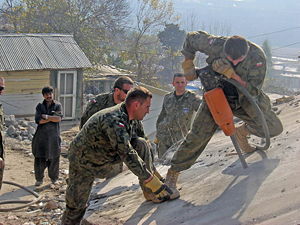
Poland is a republic. The chief of state is a president who is elected by popular vote for a five-year term, and is eligible for a second term. The president appoints the prime minister and deputy prime ministers, as well as the cabinet according to the proposals of the prime minister, both typically from the majority coalition.
The Polish Parliament has two chambers. The lower chamber (Sejm) has 460 members, elected for a four-year term by proportional representation in multi-seat constituencies, with a five percent threshold (eight percent for coalitions, threshold waived for national minorities). The Senate (Senat) has 100 members elected for a four year term in 40 multi-seat constituencies under a rare plurality bloc voting method where several candidates with the highest support are elected from each electorate.
When sitting in joint session, members of the Sejm and Senate form the National Assembly, (Polish Zgromadzenie Narodowe). The National Assembly is formed on three occasions: Taking the oath of office by a new president, bringing an indictment against the President of the Republic to the Tribunal of State, and declaration of a president's permanent incapacity to exercise their duties due to the state of their health. Only the first kind has occurred to date.
On the approval of the Senate, the Sejm also appoints the Ombudsman or the Commissioner for Civil Rights Protection (Rzecznik Praw Obywatelskich) for a five-year term. The Ombudsman has the duty of guarding the observance and implementation of the rights and liberties of Polish citizens and residents, of the law and of principles of community life and social justice.
The judicial branch comprises the Supreme Court of Poland (Sąd Najwyższy); the Supreme Administrative Court of Poland (Naczelny Sąd Administracyjny); the Constitutional Tribunal of Poland (Trybunał Konstytucyjny); and the State Tribunal of Poland (Trybunał Stanu). Poland has a mixture of Continental (Napoleonic) civil law and holdover communist legal theory, although the latter is being gradually removed as part of a broader and ongoing reform process. The Constitutional Tribunal supervises the compliance of statutory law with the Constitution, and annuls laws which do not comply. Its rulings are final (since October 1999); court decisions can be appealed to the European Court of Human Rights in Strasbourg.
Administrative divisions
Poland's provinces ("voivodeships") are largely based on the country's historic regions, whereas those of the past two decades (till 1998) had been centered on and named for individual cities. The new units range in areas from under 10,000 km² (Opole Voivodeship) to over 35,000 km² (Masovian Voivodeship). Voivodeships are governed by voivod governments, and their legislatures are called voivodeship sejmiks.
Poland is subdivided into 16 administrative regions known as voivodeships (województwa, singular województwo). In turn, the voivodeships are divided into powiaty (singular powiat), second-level units of administration, equivalent to a county, district or prefecture in other countries (NUTS-4 or rather LAU-1) and then gminy ("communes", singular gmina).
Foreign relations
Poland has forged ahead on its economic reintegration with the West. Poland became a full member of NATO in 1999, and of the European Union in 2004. Poland became an associate member of the European Union (EU) and its defensive arm, the Western European Union (WEU) in 1994. In 1996 Poland achieved full OECD membership and submitted preliminary documentation for full EU membership. Poland joined the European Union in 2004, along with the other members of the Visegrád group.
Changes since 1989 have redrawn the map of central Europe, and Poland has had to forge relationships with seven new neighbors. Poland has signed friendship treaties replacing links severed by the collapse of the Warsaw Pact. The Poles have forged special relationships with Lithuania and particularly Ukraine in an effort to firmly anchor these states to the West. Poland is a part of the multinational force in Iraq.
The military
Wojsko Polskie (Polish Army) is the name applied to the military forces of Poland. The name has been used since the early nineteenth century. Polish Armed Forces consist of the Army, which comprises 168,000 persons, Navy, 15,976 persons, and Air Force, 31,147 persons. As of 2006, professional soldiers made up 60 percent of military personnel, while the current government of Poland intended to make the army fully professional by 2012 by ending the draft or reducing it to short training of recruits that would last up to two or three months. Conscripts were required to do nine months service and every male aged 18 was due for this service. The Polish military continues to use mostly Soviet-era equipment, however after joining NATO in 1999 Poland has begun upgrading and modernizing its hardware to NATO standards.
Economy
Poland has pursued a policy of economic liberalization since 1990 and in 2007 stood out as a successful example of the transition from a state-directed economy to a primarily privately owned market economy. Its principal economic activities involve industry. Before World War II, industry was concentrated in coal, textile, chemical, machinery, iron, and steel sectors. Today it extends to fertilizers, petrochemicals, machine tools, electrical machinery, electronics, cars and shipbuilding.
The people of Poland have an improved standard of living. Poland ranked 37th in the 2006 HDI, 48th on The Economist's 2005 world-wide quality-of-life index, and it has an average per capita income that has been estimated at $16,599 for the year 2006, 52nd on the IMF list of 179 countries, which roughly equals that of the three Baltic states. Consumer price inflation - at 1.3 percent in 2006 - remained among the lowest in the European Union. But the unemployment rate was 14.9 percent in 2006, and 17 percent of the population existed below the poverty line in 2003.
In 2006, GDP grew 5.3 percent, based on rising private consumption, a 16.7 percent jump in investment, and burgeoning exports. Poland in 2007 had a thriving private sector which created more than 300,000 new jobs during 2006 alone. Since 2004, EU membership and access to EU structural funds has provided a major boost to the economy. Inflows of direct foreign investment exceeded $10 billion in 2006 alone - and more than $100 billion since 1990 - with major investments being announced by foreign firms in computer, consumer electronics, and automobile component production.
Since 2002, even though the zloty appreciated 30 percent, Poland's exports more than doubled. Exports totalled $117.3-billion in 2006. Export commodities included machinery and transport equipment 37.8 percent, intermediate manufactured goods 23.7 percent, miscellaneous manufactured goods 17.1 percent, food and live animals 7.6 percent. Export partners included Germany 27.2 percent, Italy 6.6 percent, France 6.2 percent, UK 5.7 percent, Czech Republic 5.6 percent, and Russia 4.3 percent. Imports totalled $122.2-billion in 2006. Import commodities included machinery and transport equipment 38 percent, intermediate manufactured goods 21 percent, chemicals 14.8 percent, minerals, fuels, lubricants, and related materials 9.1 percent. Import partners included Germany 29 percent, Russia 9.6 percent, Italy 6.4 percent, Netherlands 5.7 percent, France 5.4 percent.
Unemployment, at 14.9 percent in 2006, remained the highest in the EU. Since joining the European Union, many Poles have left their country to work in other EU countries (particularly Ireland and the UK) because of high unemployment. An inefficient commercial court system, a rigid labor code, bureaucratic red tape, and persistent corruption kept the private sector from performing to its potential.
Agriculture is handicapped by inefficient small farms and inadequate investment. Agriculture employs 16.1 percent of the work force but contributes only 3.8 percent to the gross domestic product (GDP), reflecting relatively low productivity. Poland's two million private farms occupy 90 percent of all farmland and account for roughly the same percentage of total agricultural production. Farms are small—8 hectares on average—and often fragmented.
Restructuring and privatization of the remaining state-owned industries, especially "sensitive sectors" such as coal, oil refining, railroads, and energy transmission and generation, have stalled due to concerns about loss of control over critical national assets and lay-offs. Reforms in health care, education, the pension system, and state administration have failed so far to reduce the government budget deficit, which was roughly 2.7 percent of GDP in 2006. Further progress in public finance depends mainly on reducing losses in Polish state enterprises, restraining entitlements, and overhauling the tax code.
The previous Socialist-led government introduced a package of social and administrative spending cuts to reduce public spending by about $17-billion through 2007, but full implementation of the plan was trumped by election-year politics in 2005. The right-wing Law and Justice party won parliamentary elections in September 2005, and Lech Kaczynski won the presidential election in October, running on a state-interventionist fiscal and monetary platform. The new government has proceeded cautiously on economic matters, however, retaining, for example, the corporate income tax cuts initiated by the previous administration and indicating its intention to reduce the top personal income tax rate.
Demographics
Population
Poland's total population in 2007 was 38,530,080, the eighth-largest population in Europe. In the first decade of the 21st century, Poland's population has decreased because of an increase in emigration and a sharp drop in the birth rate. The median age for the total population of 37.3 years. The number of Poles living abroad is estimated at around 20 million. Poles had an average life expectancy at birth of 70.3 years for males and 78.8 years for females in 2004.
Ethnicity
Poles make up 96.7 percent of the population, Germans 0.4 percent, Belarusians 0.1 percent, Ukrainians 0.1 percent, as well as Tatars, Lithuanians, Roma, Lemkos, Russians, Karaites, Slovaks, and Czechs. Among foreign citizens, the Vietnamese are the largest ethnic group, followed by Greeks, and Armenians, which total 2.7 percent, according to the 2002 census. In terms of ethnicity, Poland has been regarded as a homogeneous state since the end of World War II.
Polish people, or Poles, are a western Slavic ethnic group of Central Europe, living predominantly in Poland. The West Slavs are Slavic peoples speaking West Slavic languages, and include Poles, as well as Czechs, Kashubians, Slovaks, and Sorbs. Poles are sometimes defined as people who share a common Polish culture and are of Polish descent. Their religion is predominantly Roman Catholic. The Poles can also be referred to as the inhabitants of the Republic of Poland and Polish emigrants irrespective of their ethnicity. A wide-ranging Polish diaspora exists throughout Western and Eastern Europe, the Americas and Australia.
Religion
Due to the Holocaust and the flight and removal of Germans during and after World War II, Catholics make up about 90 percent of the population (94.8 percent according to church baptism statistics) with 46 percent as practising Catholics (according to opinion polls). The 1989 Polish constitution guarantee the freedom of religion allowed for the emergence of additional denominations. The Polish Episcopate influenced inclusion of the Catholic catechism in the school curriculum, a move criticised as unconstitutional but supported by 72 percent of respondents in a 2007 survey.
Despite a sharp drop in religious observance in recent years, Poland remains one of the most devoutly religious countries in Europe. Religious minorities include Polish Orthodox (1.3 percent or about 509,500), Jehovah’s Witnesses (0.3 percent or about 123,034), Eastern Catholics (0.2 percent), Lutherans (0.2 percent), and smaller minorities of Mariavites, Polish Catholics, Pentecostals, Seventh-Day Adventists, Jews, Muslims (including the Tatars of Białystok) and various Protestants (about 86,880 in the largest Evangelical-Augsburg Church, plus about as many in smaller churches).
In the Eurostat - Eurobarometer poll of 2005, 80 percent of Polish citizens responded that they believe there is a God, whereas 15 percent answered that they believe there is some sort of spirit or life force, and one percent that they do not believe there is a God, spirit, nor life force. Poland’s percentage of respondents asserting that they believe there is a God was the fourth highest among EU members behind Malta , Cyprus, Greece, and Portugal.
Language
Polish is the official language and is spoken by 97.8 percent of the population. It belongs to the west Slavic group of languages of the Indo-European language family. Poles use the Latin alphabet. Literary Polish developed during the sixteenth century, and a new vocabulary was introduced from the nineteenth century, taking words from German, Latin, Russian, and English, with spelling alterations to reflect the Polish alphabet. There are regional dialects — Great Polish in the northwest, Kuyavian to the east, and Little Polish around Cracow.
Men and women
In the cities, both men and women work outside the home, but more women are unemployed than men, while in rural areas, women work both in the fields and in the house. The Polish have the term "the second shift", which describes simultaneously managing an external job and a household. A Polish man will do almost anything not to cook, wash dishes, or clean house, while shopping for groceries is considered women's jobs. Under the communist regime, women attained opportunities for higher education and employment. By 1990, women and men had accumulated the same 11.1 years of education, although women's earnings were lower. The reappearance of a market economy has meant that although women make up less than 50 percent of the workforce, 55 percent of the unemployed are women. Moreover, women are subject to violence at home and sexual harassment at work, have less access to credit, and few women have achieved top positions in politics, business, and the professions. They are excluded from leadership in the Catholic Church.
Marriage and the family
People typically married before the age of 20, and both men and women expect to marry, have children, and have only one spouse for a lifetime. Marriage is regarded as a holy responsibility, and it was believed that the unmarried could not be happy and would have difficulty obtaining salvation. Traditionally, most marriages were arranged to improve family finances. Divorce was difficult. The traditional domestic unit was a three-generation family consisting of the married couple, their children, and the husband's parents. By 1991, over six percent of families consisted of a single mother with children. Regarding inheritance, traditionally, a father could divide the inheritance any way he wanted, although by the twenty-first century, there were legal restrictions.
Education
Children start primary school aged seven. Next is the lower secondary level consisting of three years in gymnasium, starting at the age of 13, which ends with an exam. This is followed by upper secondary level, which has several alternatives, the most common being the three years in a liceum or four years in a technikum. Both end with a maturity examination (matura, roughly equivalent to British A-levels examination and quite similar to French baccalauréat). There are several forms of tertiary education, leading to licencjat or inżynier (Polish equivalents of Bachelor's degree), magister (Polish equivalent of Master's degree) and eventually doktor (Polish equivalent of Ph.D. degree). Regarding literacy, 99.8 percent of the total population over the age of 15 could read and write in 2003.
Class
The rigid class structure that marked Poland before 1939 was ended during World War II, when the Nazis and the Communists killed educated Poles, and during the Communist regime, when government policies aimed to reduce social classes. In the late twentieth century, there were six groupings: peasants, workers, intelligentsia, szlachta (nobles or gentry), the nomenclatura (communist ruling class), and a nascent middle class. Since the downfall of the communist government, workers and intelligentsia have increased in numbers, while the nomenclatura has struggled to regain political power and maintain economic power. While the szlachta may constitute up to 15 percent of the population, their significance has been eliminated. During Communist rule, many assumed the customs of the szlachta. For those above the peasant and worker classes, men kiss women's hands and follow fashions in clothing. The educated and the szlachta stress politeness and social graces to differentiate themselves from the uneducated and the newly rich.
Culture
Polish culture has been influenced by both West and East. Today, these influences are evident in Polish architecture, folklore, and art. Poland is the birthplace of some world famous people, including Pope John Paul II (Polish: Papież Jan Paweł II), Marie Skłodowska Curie (Polish: Maria Skłodowska-Curie), Kazimierz Pułaski (Template:Lanomg-pl), Nicolaus Copernicus (Polish: Mikołaj Kopernik) and Frederic Chopin (Polish: Fryderyk Chopin).
Architecture
Polish towns reflect the whole spectrum of European styles. Poland's Eastern frontiers used to mark the outermost boundary of the influences of Western architecture on the continent.
History has not been good to Poland's architectural monuments. However, a number of ancient edifices have survived: castles, churches, and stately buildings, sometimes unique in the regional or European context. Some of them have been painstakingly restored (the Wawel), or completely reconstructed after being destroyed in the Second World War (the Old Town and Royal Castle in Warsaw, the Old Towns of Gdańsk and Wrocław). Kazimierz Dolny on the Vistula is an example of a well-preserved medieval town. Kraków ranks among the best preserved Gothic and Renaissance urban complexes in Europe. Polish church architecture deserves special attention. There is an one of the best preserved examples of complex Modernist Movement architecture in Europe in Katowice, Upper Silesia, designed and built in Thirties. Some interesting buildings were also constructed during the Communist regime in the style of Socialist Realism; some remarkable examples of modern architecture erected recently.
Art
Polish art has always reflected world trends while maintaining its unique character. Jan Matejko's famous school of Historicist painting produced monumental portrayals of significant events in Polish history. Stanisław Witkiewicz was an ardent supporter of Realism in Polish art, its main representative being Jozef Chełmoński. The Młoda Polska (Young Poland) movement witnessed the birth of modern Polish art, and engaged in a great deal of formal experimentation, led by Jacek Malczewski (Symbolism), Stanisław Wyspiański, Józef Mehoffer, and a group of Polish Impressionists. Artists of the twentieth-century Avant-Garde represented various schools and trends. The art of Tadeusz Makowski was influenced by Cubism; while Władysław Strzemiński and Henryk Stażewski worked within the Constructivist idiom. Distinguished contemporary artists include Roman Opałka, Leon Tarasewicz, Jerzy Nowosielski, Wojciech Siudmak, and Mirosław Bałka and Katarzyna Kozyra in the younger generation. The most celebrated Polish sculptors include Xawery Dunikowski, Katarzyna Kobro, Alina Szapocznikow and Magdalena Abakanowicz. Since the inter-war years, Polish art and documentary photography has enjoyed worldwide recognition. In the sixties the Polish Poster School was formed, with Henryk Tomaszewski and Waldemar Świerzy at its head.
Cinema
Graduates of the famous Łódź Film School include many celebrated directors, among them Roman Polański (Knife in the Water, Rosemary's Baby, Frantic, The Pianist) and Krzysztof Zanussi, a leading director of the cinema of moral anxiety of the 70s. Andrzej Wajda's films offer an insightful analysis of what is universal in the Polish experience - the struggle to maintain human dignity under circumstances which hardly allow it. His major films describe the identity of many of Poland's generations. In 2000 Wajda was awarded an Oscar for his contribution to cinema. In the 90s the films of Krzysztof Kieślowski, such as The Decalogue (made for television), The Double Life of Véronique and the Three Colors trilogy, won great popularity. Other Polish film directors such as Agnieszka Holland and Janusz Kamiński have worked in Hollywood as well. Polish animated films - represented by Jan Lenica and Zbigniew Rybczyński (awarded an Oscar in 1983) - have a long tradition, and derivie inspiration from Poland's graphic arts.
Cuisine
Polish cuisine (Polish: kuchnia polska) is a mixture of Slavic, Jewish and foreign culinary traditions. Born as a mixture of various culinary traditions, both of various regions of Poland and surrounding cultures, it uses a fair variety of ingredients. It is rich in meat, especially pork, cabbage (for example in the dish bigos), and spices, as well as different kinds of noodles and dumplings, the most notable of which are the pierogi. It is related to other Slavic cuisines in usage of kasza and other cereals, but was also under the heavy influence of Turkic, Germanic, Hungarian, Jewish, French, Italian or colonial cuisines of the past. Generally speaking, Polish cuisine is substantial. Poles allow themselves a generous amount of time to enjoy their meals, with some meals taking a number of days to prepare in their entirety.
A typical lunch is usually composed of at least three courses, starting with a soup, such as barszcz (beet) or żurek (sour rye meal mash), followed perhaps in a restaurant by an appetizer of salmon or herring (prepared in either cream, oil, or vinegar). Other popular appetizers are various meats, vegetables or fish in aspic. The main course may be the national dish, bigos (cabbage with pieces of meat, mostly pork) or kotlet schabowy (breaded pork cutlet). Meals often conclude with a dessert such as ice cream (lody), makowiec (poppy seed cake), or drożdżówka, a type of yeast cake. Other Polish specialities include chłodnik (a chilled beet or fruit soup for hot days), golonka (pork knuckles cooked with vegetables), kołduny (meat dumplings), zrazy (stuffed slices of beef), salceson and flaczki (tripe). Many dishes contain quark.
Notable foods in Polish cuisine include Polish sausage (Polish: kiełbasa), red beet soup (Polish: barszcz), Polish dumplings (Polish: pierogi), tripe soup (Polish: flaczki), cabbage rolls (Polish: gołąbki), Polish pork chops (Polish: kotlety schabowe), Polish traditional stew (Polish: bigos), various potato dishes, a fast food sandwich zapiekanka, and many more. Traditional Polish desserts include Polish doughnuts (Polish: pączki), Polish gingerbread (Polish: pierniki) and others.
Dance
Dances of Poland include: the Polonaise, the Krakowiak, the Kujawiak, the Mazurka, the Oberek, and the troika. The polonaise (Polish: polonez, chodzony; Italian: polacca) is a rather slow dance of Polish origin, in 3/4 time. Its name is French for "Polish." The notation alla polacca on a score indicates that the piece should be played with the rhythm and character of a polonaise (e.g., the rondo in Beethoven's Triple Concerto op. 56 has this instruction).
Before Frédéric Chopin, the polonaise had a rhythm quite close to that of the Swedish semiquaver or sixteenth-note polska, and the two dances have a common origin. From Chopin onward, the polonaise developed a very solemn style, and has in that version become very popular in the classical music of several countries.
One fine example of a polonaise is the well-known 'Heroic' Polonaise in A flat major, Op.53. Chopin composed this polonaise as the dream of a powerful, victorious and prosperous Poland.
Polonaise is a wide-spread dance on carnival parties. There is also a German song, called "Polonäse Blankenese" from Gottlieb Wendehals alias Werner Böhm, which is often played on carnival festivals in Germany about this dance. Polonaise is always a first dance at a studniówka (means: "hundred-days"), the Polish equivalent of the senior prom, which is ca. 100 days before exams.
The Krakowiak, sometimes referred to as the Pecker Dance, is a fast, syncopated Polish dance in duple time from the region of Krakow and Little Poland. It became a popular ballroom dance in Vienna ("Krakauer") and Paris ("Cracovienne")— where, with the polonaise and the mazurka, it signalled a Romantic sensibility of sympathy towards a picturesque, distant and oppressed nation— and in Russia in the mid-nineteenth century. A krakoviak is featured in Mikhail Glinka's A Life for the Tsar (1836).
The mazurka (Polish: mazurek, named after Poland's Mazury (Masuria) district; mazurka is the feminine form of mazurek) is a Polish folk dance in triple metre with a lively tempo, containing a heavy accent on the third or second beat. It is always found to have either a triplet, trill, dotted quaver pair, or ordinary quaver pair before two crotchets. The dance became popular at Ballroom dances in the rest of Europe during the nineteenth century. The Polish national anthem has a mazurka rhythm, but is too slow to be considered a mazurka.
Several classical composers have written mazurkas, with the best known being the 57 composed by Frédéric Chopin for solo piano, the most famous of which is the Mazurka nr. 5. Henryk Wieniawski wrote two for violin with piano (the popular "Obertas", op. 19), and in the 1920s, Karol Szymanowski wrote a set of twenty for piano.
Literature
The origins of Polish literature written in the Polish vernacular go back beyond the 14th century. In the 16th century the poetic works of Jan Kochanowski established him as a leading representative of European Renaissance literature. Baroque and Neo-Classicist belle letters made a significant contribution to the cementing of Poland's peoples of many cultural backgrounds. The early 19th century novel "Manuscrit trouvé à Saragosse" by Count Jan Potocki, which survived in its Polish translation after the loss of the original in French, became a world classic. Wojciech Has' film based on it, a favourite of Luis Buñuel, later became a cult film on university campuses. Poland's great Romantic literature flourished in the 19th century when the country had lost its independence. The poets Adam Mickiewicz, Juliusz Słowacki and Zygmunt Krasiński, the "Three Bards," became the spiritual leaders of a nation deprived of its sovereignty, and prophesied its revival. The novelist Henryk Sienkiewicz, who won the Nobel Prize in 1905, eulogised the historical tradition. It is difficult to grasp fully the detailed tradition of Polish Romanticism and its consequences for Polish literature without a thorough knowledge of Polish history.
In the early 20th century many outstanding Polish literary works emerged from the new cultural exchange and Avant-Garde experimentation. The legacy of the Kresy Marchlands of Poland's Eastern regions with Wilno and Lwów (now Vilnius and Lviv) as two major centres for the arts, played a special role in these developments. This was also a region in which Jewish tradition and the mystic movement of Hasidism thrived. The Kresy were a cultural trysting-place for numerous ethnic and national groups whose achievements were inspiring each other. The works of Bruno Schulz, Bolesław Leśmian, and Józef Czechowicz were written there. In the south of Poland, Zakopane was the birthplace of the avant-garde works of Stanisław Ignacy Witkiewicz (Witkacy). And, last but not least, there was Władysław Reymont awarded 1924 Nobel prize in literature for his novel Chłopi (The Peasants).
After the Second World War many Polish writers found themselves in exile, with many of them clustered around the Paris-based "Kultura" publishing venture run by Jerzy Giedroyc. The group of emigre writers included Witold Gombrowicz, Gustaw Herling-Grudziński, Czesław Miłosz, and Sławomir Mrożek.
Zbigniew Herbert, Tadeusz Różewicz, Czesław Miłosz (Nobel Prize in 1980), and Wisława Szymborska (Nobel Prize in 1996) are among the most outstanding 20th century Polish poets, including novelists and playwrights Witold Gombrowicz, Sławomir Mrożek, and Stanisław Lem (science fiction). The long list includes Hanna Krall whose reportage focuses mainly on the war-time Jewish experience, and Ryszard Kapuściński with books translated into many languages.
Music
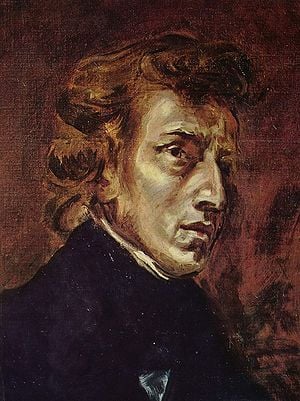
The music of Fryderyk Chopin, inspired by Polish tradition and folklore, conveys the quintessence of Romanticism. Since 1927, the International Frederick Chopin Piano Competition has been held every five years in Warsaw. Polish classical music is also represented by composers like Karol Szymanowski, Mieczysław Karłowicz, Witold Lutosławski, Wojciech Kilar, Henryk Mikołaj Górecki, and Krzysztof Penderecki - all of whom rank among the world's most celebrated composers. (An album of Gorecki's Symphony No. 3, subtitled Symphony of Sorrowful Songs, has sold over 700,000 copies.) Contemporary Polish jazz with its special national flavour has fans and followers in many countries. The best-known jazzmen are Krzysztof Komeda, Michał Urbaniak, Adam Makowicz, and Tomasz Stańko. Successful composers of film music include Jan A.P. Kaczmarek, Wojciech Kilar, Czesław Niemen and Zbigniew Preisner.
Famous modern singers, musicians and bands from Poland include Behemoth, Myslovitz, SBB, Riverside, Edyta Górniak, Lady Pank, Anita Lipnicka and Ich Troje.
Theatre
The Polish avant-garde theatre is world-famous, with Jerzy Grotowski as its most innovative and creative representative. One of the most original twentieth-century theatre personalities was Tadeusz Kantor, painter, theoretician of drama, stage designer, and playwright, his ideas finding their culmination in the theatre of death and his most recognised production being "Umarła klasa" (Dead Class).
Sport
Poland's national sports include football, volleyball, hockey, basketball and handball. Soccer is the country's most popular sport, with a rich history of international competition. Poland has also made a distinctive mark in motorcycle speedway racing thanks to Tomasz Gollob, a highly successful Polish rider. The Polish mountains are the ideal venue for hiking, skiing and mountain biking and attract millions of tourists every year from all over the world. Baltic beaches and resorts are popular locations for fishing, canoeing, kayaking and a broad-range of other water-themed sports.
Other images
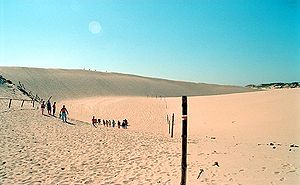
ReferencesISBN links support NWE through referral fees
- ↑ Central Statistical Office of Poland (2007). Mały Rocznik Statystyczny 2007. Retrieved 15 August, 2007.
- Teeple, J. B. (2002). Timelines of World History. Publisher: DK Adult.
External links
- Poland World Fact Book 2007, accessed November 23, 2007.
- Culture of Poland Countries and Their Cultures No-Sa, accessed November 25, 2007.
- Poland.gov.pl - Polish national portal
- Ministry of Foreign Affairs
- Background Note: Poland
- Travel guide to Poland from Wikitravel
Credits
New World Encyclopedia writers and editors rewrote and completed the Wikipedia article in accordance with New World Encyclopedia standards. This article abides by terms of the Creative Commons CC-by-sa 3.0 License (CC-by-sa), which may be used and disseminated with proper attribution. Credit is due under the terms of this license that can reference both the New World Encyclopedia contributors and the selfless volunteer contributors of the Wikimedia Foundation. To cite this article click here for a list of acceptable citing formats.The history of earlier contributions by wikipedians is accessible to researchers here:
- Poland history
- Warsaw history
- History_of_Poland history
- Prehistory_of_Poland_until_966 history
- Politics_of_Poland history
- Foreign_relations_of_Poland history
- Poles history
- Education_in_Poland history
- Culture_of_Poland history
- Polish_cuisine history
The history of this article since it was imported to New World Encyclopedia:
Note: Some restrictions may apply to use of individual images which are separately licensed.

